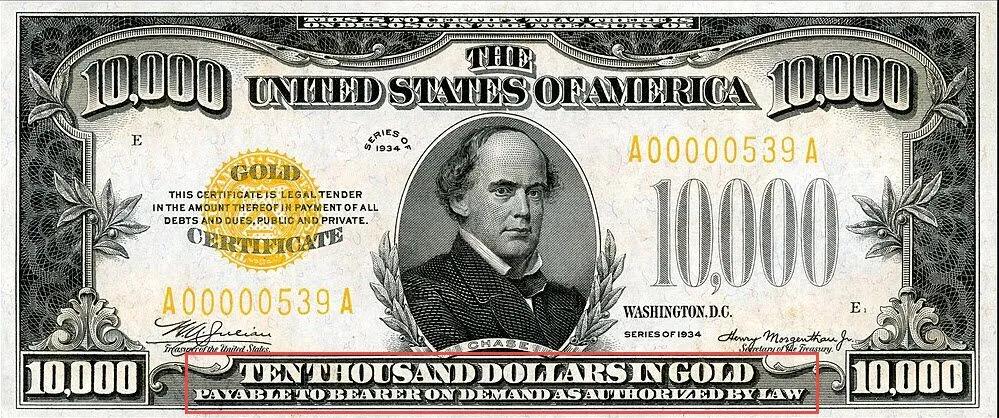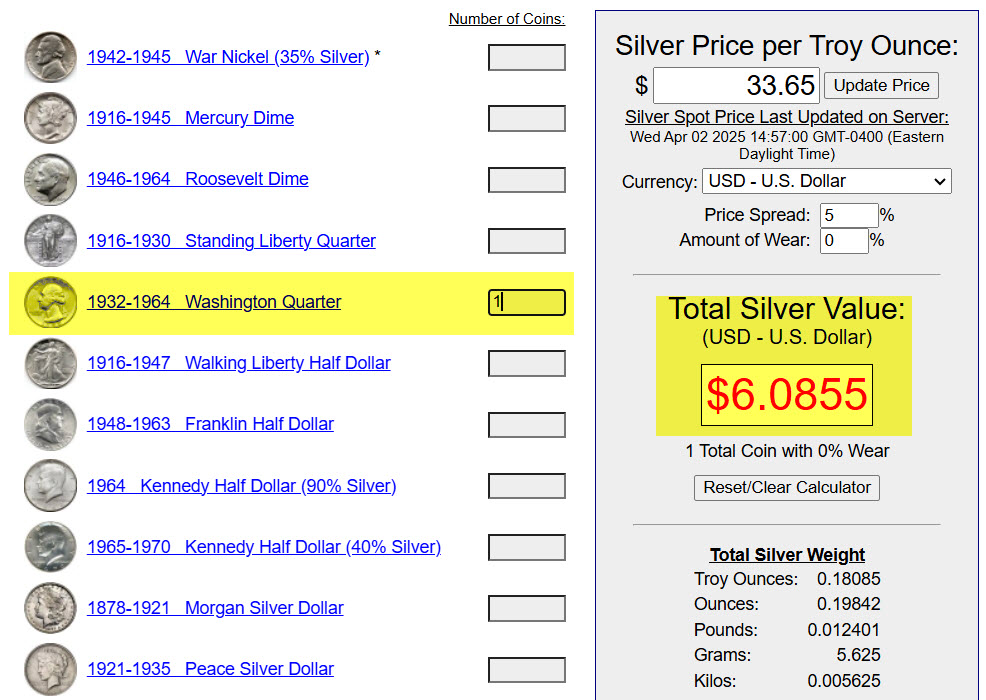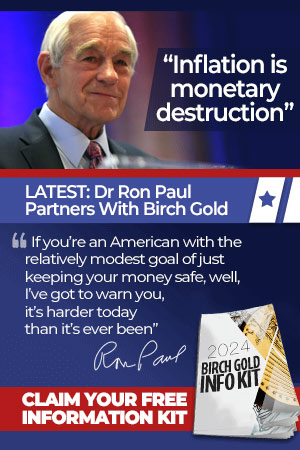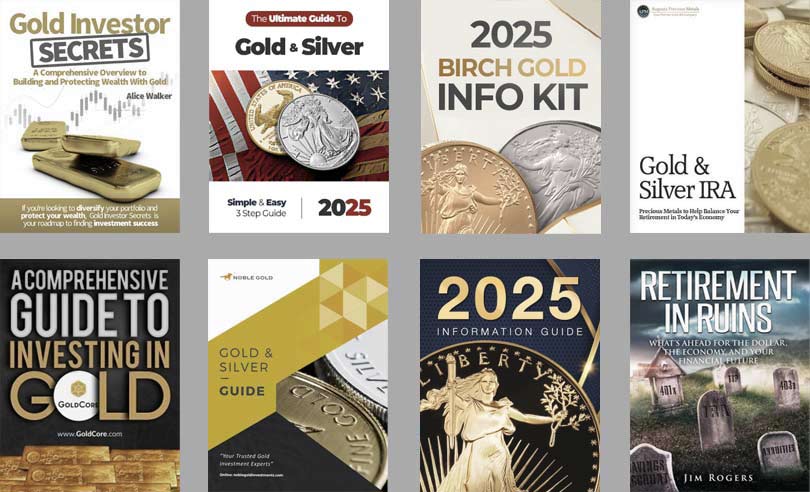Gold’s unpredictable trend toward $4,000
 Bullion.Directory precious metals analysis 03 April, 2025
Bullion.Directory precious metals analysis 03 April, 2025
By Peter Reagan
Financial Market Strategist at Birch Gold Group
Merk says we are now seeing perhaps the biggest shift since the end of World War II, one where the U.S. will no longer be the world’s police force. (The turning point was the invasion of Ukraine, when the greatest weapon in our economic arsenal, weaponizing the dollar against Russia, failed spectacularly.)
That was the final sanction that broke the proverbial camel’s back. This isn’t a fringe opinion – pretty much every analyst has made the same point repeatedly.
Russia decided it could thrive without access to SWIFT and the Western financial system generally. Ever since, they’ve been freely trading both gold and oil – and even struggled with an overheating economy, although the specific causes of the boom are more complex.
From the perspective of the rest of the world, though? The U.S. did its worst to sabotage the Russian economy, weaponizing the dollar to a truly unprecedented degree. Crossing a line which had never been crossed before… Russia not only survived but thrived in the aftermath.
Not only does that make a mockery of Western economic dominance, it forcibly reminded the rest of the world of two things:
- The U.S. dollar is nothing but an IOU. A promise to pay. Perhaps a less-than-ideal basis for a global financial system…
- Gold offers independence from both the global financial system, but also from Western political pressure.
So, the dollar now faces an unprecedented loss of faith.
On one hand, we have what Alasdair Macleod has been saying: gold is going up because people don’t trust in the dollar from a purchasing power standpoint.
But on the other, sovereign nations have not only lost faith in the U.S. dollar’s safety, but in its purchasing power as well.
By this point, even a gold standard might not restore faith fully. Consider, for a moment, that paper gold certificates (like this one) only work if the Treasury Department really has the gold, and really will honor the agreement to trade the piece of paper for the gold:

In order to create a form of money that doesn’t require trust, we’d need to return to gold and silver coinage.
Exciting things to ponder! Even if our $36 trillion indebted government is likely too far gone to really consider a return to real money…
We’re still seeing some talk about gold’s price rising, despite after-inflation interest rates holding steady. Last week, I said that’s because keeping interest rates higher than inflation, in the long term, simply isn’t sustainable. Nobody is buying it. Furthermore, we’ve already begun a rate cutting cycle – rates are almost certainly going down rather than up.
Merk, Bridgewater and Goldman Sachs each have a slightly different take. Though they agree on one thing: Weaponizing the dollar – breaking the world’s trust in the dollar itself – broke gold’s correlation with interest rates.
Merk says it broke the correlation with basically everything, and that now, all bets are off regarding gold’s correlation with other financial assets. (Might I suggest gold is correlated with nothing anymore, and is finally returning to its historic role as money? Too early, sure, but it’s worth a think.)
Meanwhile, JPMorgan analysts wondered out loud just how close $4,000 gold is:
“With each $1,000 phase taking about two-thirds less time than the previous one, and considering the law of diminishing returns alongside investors’ attraction for round numbers, could the $4,000 mark be just around the corner?”
Remember, folks, gold was $1,650 less than two years ago. This repricing looks more like that of 2000-2011, less like the 2008-2011 period…
Regardless of where gold’s price lands in the months and years ahead, I believe gold owners will be delighted. And that those who preferred to pretend that cash isn’t trash?
Well, I strongly suspect they’ll regret that decision.
Why are individual states giving up on the dollar?
This in-depth analysis from Kevin Stocklin on The Epoch Times shows us a couple of things, starting with just how badly the U.S. dollar has betrayed American citizens.
We keep being told that gold merely holds purchasing power. Well, that’s a safe argument, for sure! Gold right now is worth no more than it was 50 years ago in real (after-inflation) purchasing power.
Is that true? It doesn’t seem true…
So let’s look at the numbers. How gold’s price compares to home prices. After all, a home is just one of the many things the average American family can no longer afford.
Purchasing a home has gone from a rite of passage in your 20s to a luxury you might be able to afford, if you work hard and are moderately successful in your career and save a lot, by the time you’re 60.
Utah State Representative Ken Ivory, who has been spearheading the sound money movement with state legislation – and through spreading awareness of the benefits of sound money. (If the legislation he sponsored passes, Utah will be the first state to pass a “transactional gold” bill!)
Representative Ivory tells us:
“In 1971, you could buy a house for $20,000 in Salt Lake, or 563 ounces of gold. Today, the average house is pushing $600,000, but with 563 ounces of gold you can buy more than three houses.”
In other words, something doesn’t add up. Could it be that “official” inflation numbers are, as Ron Paul told us, “just plain nonsense”? Or could it be that gold’s purchasing power actually grows over time?
Representative Ivory continues:
“Houses aren’t more expensive; they’re less expensive than ever on a fixed standard. But our dollar has become this illusory standard where we’ve got unelected people deciding what the inflation rate is, which means how much of our money they’re going to take every year.”
He captures three key points in just a few sentences:
- The dollar is not a safe store of purchasing power
- Inflation is theft
- (Historically speaking), gold is better
Straight to the point!
The dollar is a tool for our government to stealthily tax us, to redistribute our wealth for their purposes. Inflation, like taxes and fines and licensing fees, is merely another tool for governments to control us. We don’t want it! One of the few things the left, right and center all agree on is that we all hate inflation! We protest against it! For over 50 years – and nothing has changed.
Individual states are realizing that the federal government isn’t going to do anything to improve the situation. So they’re taking matters into their own hands – diversifying their state reserves with physical gold and silver.
The Epoch Times frames it in an interesting way, one we’ve also covered in the past to a degree, which is a reverse Gresham’s Law.
The way it’s supposed to work is simple: “Bad money drives out the good.” So when the U.S. Mint stopped putting silver in our dimes and quarters back in 1965, the pre-1964 coins (now worth more than their face value) disappeared. Here’s why:

Silver coin melt value calculator via CoinApps.com
Only an utter fool (or a child) would willingly part with a $6 coin in exchange for 25¢ worth of – of anything. (What CAN you still buy for a quarter?) So the “good” money, real silver coinage, vanishes into hiding places. People spend the “bad” money, the modern copper-nickel coin whose intrinsic value is about the same as its face value.
There might have been a point where bad money was able to drive out good money, but that appears to have long passed. These days, people everywhere want good money. They’re sick and tired of bad money.
What these states are attempting to do is just that. By allowing citizens the option to trade in gold and silver as legal tender, they hope to essentially force the depreciating dollar out. And it might just work.
Just suppose you were able to receive your paycheck in gold for the first half of 2023 and saved 30% or even 10% of it monthly. You’d be a whole lot better off than if you saved in U.S. dollars, wouldn’t you?
The more people recognize this, along with allowing states to individually mint and hold gold, the less appetite there will be for the U.S. dollar.
Since change isn’t going to come top-down, it has to come grassroots, and on that front, it’s looking promising.
The curious case of Bosnia increasing its gold reserves to an all-time high
Bosnia recently increased its central bank gold reserves to the highest amount since the bank’s founding in 1997.
At first, this looks like yet another story of a weak economy with a weak currency buying a lot of gold, and we have had a lot of those as of late. But it’s more than that.
Bosnia’s central bank was founded in 1997 after the dismantling of Yugoslavia, which followed the break-up of the Soviet Union.
As a post-communist bloc country outside of the European Union, it consistently ranks as one of the poorest European nations. However, its currency situation is nowhere near that of, say, Libya or Iraq, whose currencies are in freefall.
Bosnia has its own version of the German mark, which is fixed to the euro, giving it a surprising amount of stability for a small and developing country. Furthermore, it’s not uncommon for Bosnians to transact in euros or even in U.S. dollars as part of their day-to-day (partly due to the euro peg).
So we have a seeming outlier. Unlike emerging market nations, Bosnia’s currency isn’t in freefall, and the central bank isn’t desperate to obtain value. But also unlike considerably better off European nations like Poland or Hungary, Bosnia doesn’t exactly have money to throw away. It isn’t privy to European Union grants or stimulus packages that EU member nations have benefited from considerably over the past two decades.
So when it massively increases its gold stockpile during all-time high prices, we might want to take note.
The official line of reason is that the purchase was for reasons of safety, which can only be interpreted as safety from the euro’s and perhaps the U.S. dollar’s fall.
The two ton purchase last year shows that anyone everywhere is buying gold. It doesn’t matter if the economy is good or bad. It doesn’t matter if the currency is in freefall or stable.
Sovereign nations want a gold hoard, and the reasons given are not nearly as interesting as the reasons speculated.
Our take remains that some kind of world order is brewing where gold will once again determine the sovereign clout of any nation.
Can we still call it a new world order, or do we have to concede we’re seeing a return to old and sound principles?
Either way, it’s a step in the right direction.
Peter Reagan

Peter Reagan is a financial market strategist at Birch Gold Group, one of America’s leading precious metals dealers, specializing in providing gold IRAs and retirement-focused precious metals portfolios.
Peter’s in-depth analysis and commentary is published across major investment portals, news channels, popular US conservative websites and most frequently on Birch Gold Group’s own website.
This article was originally published here












 Material provided on the Bullion.Directory website is strictly for informational purposes only. The content is developed from sources believed to be providing accurate information. No information on this website is intended as investment, tax or legal advice and must not be relied upon as such. Please consult legal or tax professionals for specific information regarding your individual situation. Precious metals carry risk and investors requiring advice should always consult a properly qualified advisor. Bullion.Directory, it's staff or affiliates do not accept any liability for loss, damages, or loss of profit resulting from readers investment decisions.
Material provided on the Bullion.Directory website is strictly for informational purposes only. The content is developed from sources believed to be providing accurate information. No information on this website is intended as investment, tax or legal advice and must not be relied upon as such. Please consult legal or tax professionals for specific information regarding your individual situation. Precious metals carry risk and investors requiring advice should always consult a properly qualified advisor. Bullion.Directory, it's staff or affiliates do not accept any liability for loss, damages, or loss of profit resulting from readers investment decisions.

Leave a Reply